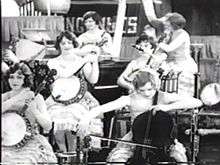The Ingenues
| The Ingenues | |
|---|---|
 The Ingenues in Maids and Music 1937 | |
| Background information | |
| Origin | Chicago, The United States |
| Genres | Jazz, Tin Pan Alley, Symphonic Jazz, Vaudeville, Popular Music |
| Years active | mid-1920s – mid-1930s |
| Labels | Vitaphone |
| Past members | Paula Jones |
The Ingenues was a vaudeville style all-girl jazz band based in Chicago, which toured the United States and other countries from 1925 to 1937. Managed by William Morris, the group performed frequently for variety theater, vaudeville and picture houses, often billed as the opening stage show before double features. They headlined the Ziegfeld Follies of 1927, Glorifying the American Girl, an act featuring 12 white baby grands as well as various combinations of brass bands, strings and woodwinds. The group specialized in jazz, Tin Pan Alley, light classical works and Dixieland. They were celebrated for their versatility as most members, including star soloist and "trick trombonist" Paula Jones, doubled on both novelty (accordions, banjos) and symphonic instruments. The group toured Europe, South Africa, Asia, Australia and Brazil (where they also recorded for Columbia Records). The band appeared in several film shorts including The Band Beautiful and Syncopating Sweeties (Vitaphone 1928) and Maids and Music (RKO, 1937). "Maids and Music" was produced independently by Milton Schwarzwald's Nu-Atlas Productions and released as a 16mm home movie by Pictoreels. Sequences from this and other Schwarzwald short subjects were also re-edited into Soundies; in the case of "Maids and Music" the Soundies excerpt was titled "Ray Fabing's Versatile Ingenues."
Clippings

Further reading
Dahl, Linda. Stormy Weather: The Music and Lives of a Century of Jazz Women (New York: Limelight 1984).
McGee, Kristin. “The Feminization of Mass Culture and the Novelty of All-Girl Bands: The Case of the Ingenues” in Popular Music and Society 31/5, 2008: 629-662.
McGee, Kristin. Some Liked it Hot: Jazz Women in Film and Television, 1928-1959 (Middletown, CT: Wesleyan University Press 2009) 34-66